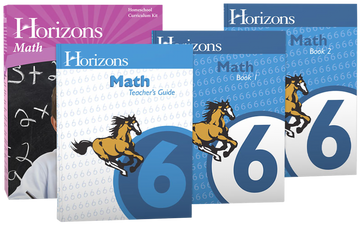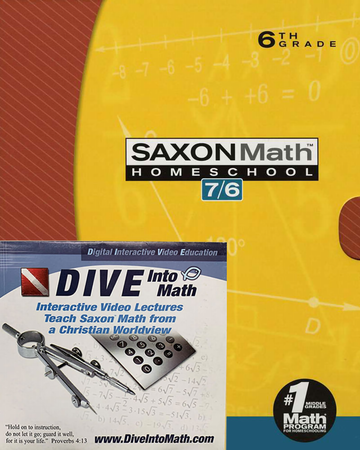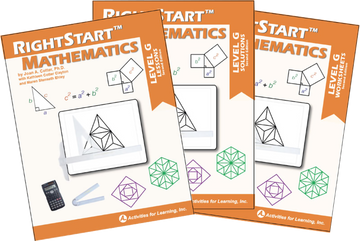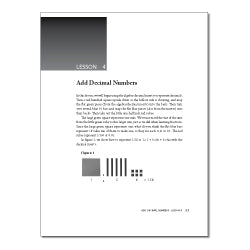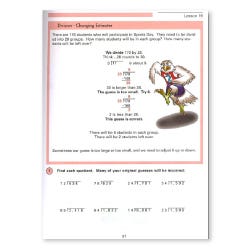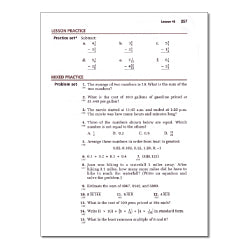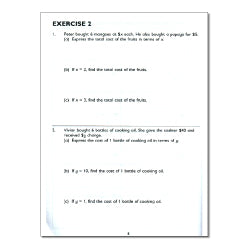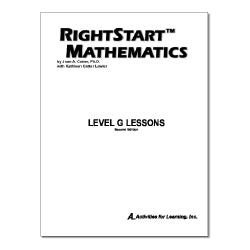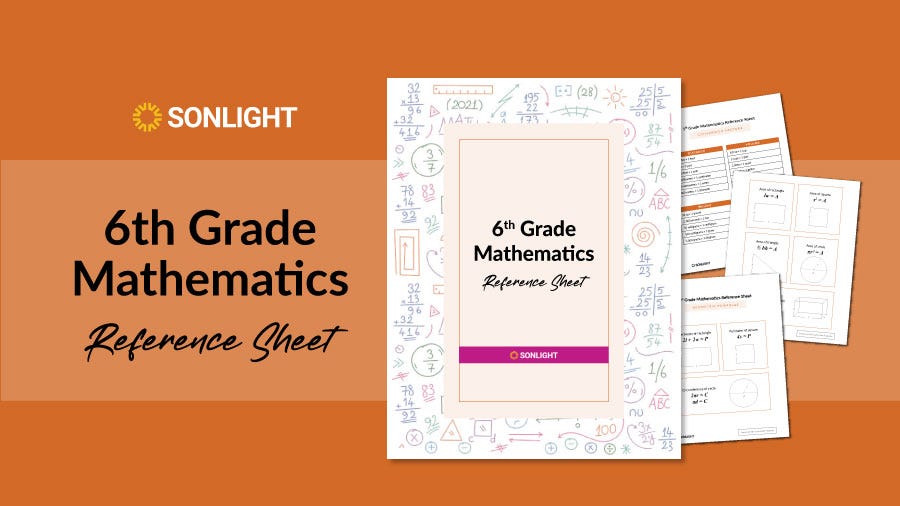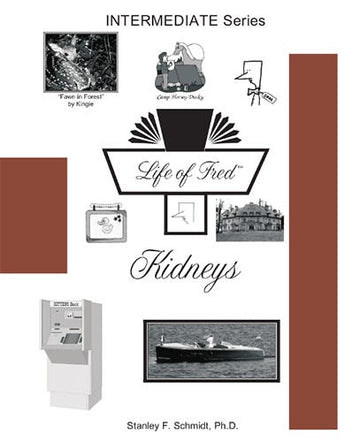6th Grade Math
Is your sixth grader meeting expectations with math? Discover sixth grade math topics, browse curriculum, learn about state tests, identify grade-level vocabulary, and see the best ways to teach math for sixth graders in this comprehensive guide to all things 6th grade math.
The Best Sixth Grade Math Curriculum
You don’t have to be a math whiz yourself to provide your child with a strong math foundation. What you need is a solid math curriculum to guide you.
When looking for the best math curriculum for sixth graders, choose from these five top picks: Horizons, Singapore, Saxon, Math U See, or RightStart Math. They’ve been successfully used to teach thousands of children at all levels (and their parents) the math they need.
$128.10
$120.00
$287.90
$104.60
Dig deeper by referencing the Homeschool Math Comparison Chart on this main math page. And, to further compare these programs, see the detailed scope and sequence of each. But if you still feel unsure, an Advisor can help you identify which program is a good fit for you.
If you’re not sure that sixth grade math is the right level for your child, use the math placement tests here to confirm the best level.
1 Math-U-See Zeta
Math-U-See is an innovative approach to learning how to do math and also understanding how math works. Using hands-on and visual methods, the Zeta level for sixth grade focuses on decimals and percentages and also covers these topics:
- the metric system
- mean, median, and mode
- probability
- geometric concepts including points, lines, rays, and angles
Each lesson takes approximately a week to complete and contains
- a short teaching video, watched by both parent and student
- worksheets to practice the concept
- a short test to demonstrate mastery
- a worksheet of review from previous lessons
2 Horizons 6 Math Program
Horizons is a spiral curriculum. This means each daily lesson includes a great deal of review of past concepts to keep skills fresh.
Horizons 6 Math covers geometric construction of angles, triangles, squares, and other shapes; exposure to integers; addition and subtraction with 2, 3, 4, 5, and 6 digits; addition and subtraction of equations; and more challenging problem solving.
Horizons math for sixth graders uses colorful illustrations and systematic review to make sure your student has a complete understanding of these concepts:
- Scientific notation
- Square roots
- Order of operations
- Counting, adding, and subtracting money and making change
- Using metric measurements for length, weight, and volume
- Multiplying and dividing whole numbers by fractions and fractions by whole numbers
- Using a compass and protractor to construct perpendicular bisectors and geometric shapes
- Graphing in all four quadrants of the cartesian plane
- Practical life skills including check writing and calculating interest
- Solving word problems
3 Saxon Math 7/6 Program
Saxon is a complete, standards-based curriculum, structured with time to learn, time to process, and time to practice. New concepts are presented in small increments and distributed across the year so no concepts or skills get dropped. Daily cumulative written practice builds understanding.
Because of the spiral approach that constantly revisits core concepts, Saxon is a solid program of math for sixth graders who struggle with math or have learning disabilities.
At the Saxon 7/6 level, students continue to develop their math skills and deepen their understanding of new concepts including:
- Order of operations
- Exponents and roots
- Fractions, decimals, and percents
- Using a ruler and compass
- Geometry, including finding unknown angle measurements
- Using pi (π) in calculations involving circles
- Finding volume of three dimensional figures including pyramids, cylinders, and prisms
4 Singapore 6 Math Program
Singapore Math is unique in its three-part approach: Concrete → Pictorial → Abstract. Lessons begin with concrete objects, move to pictures, and then finally transition to abstractions such as symbols and numerals.
Further, Singapore Math is a mastery-based program. Whereas a spiral approach includes lots of review, a mastery-based program drives home a concept thoroughly and then builds on it in subsequent lessons with the assumption that the child has mastered it. There’s much less repetition compared to a spiral program.
At the sixth grade level of Singapore Math, students deepen their understanding of concepts already covered and add to their knowledge in areas including:
- Working multi-step word problems
- Identifying and classifying 3D shapes according to the number of faces, edges, and vertices
- Finding unknown angle measurements in geometric figures
- Identifying solids from net drawings
- Finding percentages of a whole
- Working with ratios
- Organizing data and display in bar graphs and/or pie charts
- Solving equations with one variable using substitution
5 RightStart Math Level G
In RightStart Math Level G, students deepen their understanding of fractions, ratios, and decimals. This level uses hands-on strategies such as an abacus and games to teach geometric concepts including
- Pythagorean Theorem
- Pi (π)
- circles
- triangles
Because Level G is the first of two intermediate levels of the curriculum, no previous RightStart Math experience is required. Students are able to complete the lessons independently.
Sixth Grade Math Samples
Download free math worksheets with these curriculum samples for sixth grade.
Sixth Grade Math Lessons
During their first grade of middle school, sixth graders spend their math lessons in a period of transition—building on what they’ve learned in elementary grades to prepare them for higher level math in the future.
Sixth grade math lessons cover topics including solving for an unknown; finding percentages of a quantity; converting between fractions, decimals, and percentages; working with ratios; organizing and displaying data in charts and graphs; and adding, subtracting, multiplying, and dividing both whole numbers and fractions.
It’s important that sixth grade math lessons include:
- direct instruction that sequentially and clearly explains the concepts, formulas, and methods
- lots of worked examples
- plenty of practice for applying what was learned
- repetition to ensure mastery
- review and application of past information
- experience with multi-step word problems
Sixth Grade Math Reference Chart
Sixth Grade Math
Problems & Equations
Math for sixth graders includes problems and equations that cover these topics:
- Adding, subtracting, multiplying, and dividing integers, fractions, and decimals
- Using factors
- Using exponents
- Evaluating equations correctly using the Order of Operations
- Finding square roots
- Understanding and correctly applying inverse operations
- Least Common Multiple (LCM) and Greatest Common Factor (GCF)
- Recognizing equivalent fractions
- Using estimation skills to evaluate the reasonableness of an answer
- Solving Word Problems involving distance, rate, and time
- Unit Conversions
- Ratios
- Recognizing and classifying geometric figures
- Finding perimeter, area, and volume of geometric figures
- Classifying angles, solving for unknown angles
- Working with time and currency
- Probability and Statistics
Sixth Grade Math
Numbers & Operations
Sixth grade is an important year in math since concepts mastered this year lay a foundation for higher level math. Fluency of basic math facts is assumed at this stage. Automaticity with those facts frees children to focus on learning more complex math functions.
In the sixth grade, students work with these kinds of numbers:
- ratios
- percents
- fractions
- decimals
- exponents
- whole numbers
- negative numbers
- integers
Being able to confidently solve problems and equations as well as real life word problems will set up your sixth grader for success as they move into algebra in coming years.
Sixth grade math includes these operations:
- converting percents, decimals, and fractions
- adding, subtracting, multiplying, and dividing decimals
- adding, subtracting, multiplying, and dividing fractions
- order of operations
- comparing negative numbers
- plotting numbers on a coordinate plane
- figuring absolute value
- factoring
- finding least common multiple
- substituting
- combining like terms
Sixth Grade Math
Pre-Algebra & Algebra
As sixth graders solve equations and find the missing addend, minuend, factor, or divisor, they are preparing for upcoming pre-algebra and algebra. Sixth grade’s heavy focus on word problems is key in getting your student ready for the critical thinking required to master algebra.
Sixth Grade Math Standards
State standards and Common Core standards are sensible benchmarks by which to evaluate math curriculum and assess your child’s progress.
The Common Core Standards for sixth grade can be found here. Nine states have not adopted Common Core for math but have their own set of standards instead. In that case, check with the state Board of Education for sixth grade math standards.
Both Math-U-See and Saxon Math programs meet Common Core Standards though the standards may be taught in a different order than outlined on the Common Core website.
Sixth Grade Math State Tests
Public schools commonly administer a standardized math test to all sixth graders as required by the Every Student Succeeds Act of 2015 (ESSA). The act states that the test must be “challenging,” but does allow each individual state to determine what is covered on the test.
Additionally, there are some states that require standardized testing of homeschool students. You can visit the US Department of Education website to see how your specific state handles sixth grade math testing for both public school students and homeschoolers.
Although standardized tests are a divisive topic, they can provide you with valuable information about your sixth grader’s progress. As long as your student is working through a respected math program like the five options outlined above, your child should be successful on a standardized test. If you find that your child is struggling with a concept or has gaps in understanding, supplement with extra practice or a second math program.
Sixth Grade Math Vocabulary
Here are typical math vocabulary words included at the sixth grade level:
- Equilateral, Isosceles, and Scalene Triangle
- Addend, Sum
- Subtrahend, Minuend, Difference
- Factors, Product
- Divisor, Dividend, Quotient
- Acute, Right, and Obtuse Angle
- Polygon
- Quadrilateral
- Area, Perimeter, Volume
- Axis, X-Axis, Y-Axis, Coordinate Plane, Coordinates
- Convert, Conversion
- Fraction, Numerator, Denominator
- Pie Chart, Bar Graph, Histogram, Box and Whisker Plot, Dot Plot
- Acute, Obtuse, Right Triangle
- Exponent
- Square Root
- Prime, Composite Number
- Integer
- Decimal
- Percent
- Mean, Mode, Median, Range

The W. Family, Sonlighters from Upland, CA
Sixth Grade Math Supplements
Don’t need a complete math program? Try a fun supplement to reinforce your student’s math skills.
$57.99
$24.00
$24.00
$24.00
1 MathTacular!
Mathtacular 4 is a collection of short videos. Each video tackles one mathematical concept and makes it easy to understand. Use the table of contents to locate a specific item of concern or just watch the videos for fun. Level 4 focuses on giving your student the tools they need to successfully tackle word problems. A workbook is included so that your student can practice what they learn.
2 Life of Fred
With its story approach, the Life of Fred series can fill in gaps in math understanding. There are three books suitable for sixth grade math: Kidneys, Liver, and Mineshaft.
As your student works through these levels, they strengthen knowledge in fractions, volume, perimeter, exponents, unit conversions, and other topics without boring worksheets or drill. Instead your student joins Fred as he encounters math in his day-to-day life.
Through Life of Fred books, your student will learn valuable life skills like check writing and calculating a sale price. There is even a bit of grammar instruction. Each one of the books will take your student between four and six weeks to work through.

